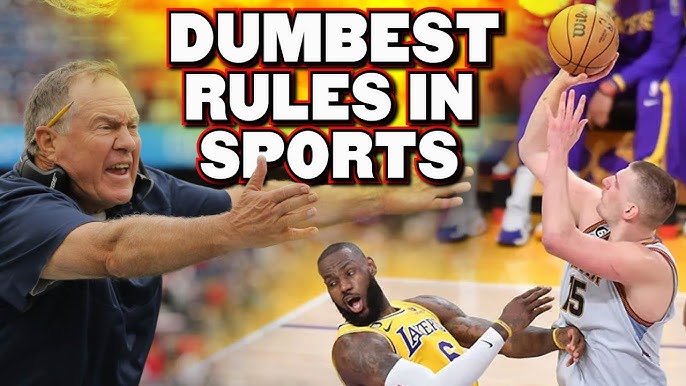

What is the dumbest rule in sports?
The concept of a "dumb" rule in sports is subjective and can vary depending on personal opinions and perspectives. What may seem like a dumb rule to one person could be an essential aspect of the game for another. However, there are a few rules in different sports that have been criticized or debated due to their perceived lack of logic or fairness. Here are a few examples:
1. The Infield Fly Rule in Baseball: The Infield Fly Rule is a rule in baseball that aims to prevent an unfair advantage for the defensive team when there are runners on first and second base (or bases loaded) with less than two outs. If an infield fly is hit, the batter is automatically out, regardless of whether the fielder catches the ball or not. Critics argue that this rule can be confusing and unfair, as it takes away the opportunity for a double play or a potential error by the fielders. However, proponents argue that the rule is necessary to prevent the defensive team from intentionally dropping a pop-up to initiate a double play.
2. The Offside Rule in Soccer: The offside rule in soccer is designed to ensure fair play and prevent goal-hanging. A player is considered offside if they are nearer to the opponent's goal line than both the ball and the second-to-last defender when the ball is played to them. However, the offside rule has been a subject of controversy and debate due to its complexity and the difficulty for referees to make accurate decisions in real-time. Critics argue that the rule slows down the game, leads to inconsistent calls, and often penalizes attacking players who are only marginally offside.
3. The Tuck Rule in American Football: The Tuck Rule, which was abolished in 2013, was a rule in American football that defined a fumble in specific situations. According to the rule, if a quarterback lost possession of the ball while attempting to tuck it back into his body after a passing motion, it was ruled an incomplete pass rather than a fumble. This rule gained infamy during a playoff game between the New England Patriots and the Oakland Raiders in 2002. The rule was heavily criticized as it seemed to favor quarterbacks and led to controversial calls where a clear fumble was overturned.
It's important to note that while these rules may be considered "dumb" by some, they were implemented for specific reasons to maintain fairness, prevent intentional rule manipulation, or ensure player safety. Rules in sports are often a result of years of refinement and trial-and-error, and what may seem illogical or unnecessary at first glance may serve a purpose within the broader context of the game.
Related Posts
© 2025 Invastor. All Rights Reserved

User Comments
Wagner Robertson
2 years ago
Pass interference. It has gone from a penalty that made sense, the defense should not be allowed to manhandle a wide receiver and totally impede his ability to catch the ball. At worst it was a 15 yard penalty. Now it's flagged if the DB even touches the WR, oh it's also a spot of the foul penalty too. Meaning you can just send your guy 50 yards down field, he trips up and sells it enough, ref flags it, and then you get a first and 10 in great field position. So so dumb.
Silva Snyder
2 years ago
I don't know anything about soccer, but whatever rule/s that encourage players to act out elaborate Shakespearean death scenes every time a dandelion seed brushes against their leg is clearly no good.
Garza Herrera
2 years ago
Golf - You can hit a perfect drive down the middle of the fairway, then have to play your second shot from a scabby crater (from where a previous player played and damaged the turf).
Richards Medina
2 years ago
Because technically the catcher is supposed to tag the batter who struck out after the third strike. I feel like the rule is ignored when the ball is caught because if the batter tried to make it to first they'd obviously be thrown out. On a wild pitch the batter might could make it. Now somebody please coherently explain a goddamn balk.
Willis Chapman
2 years ago
Can someone explain to me why (in baseball) a dropped 3rd strike allows the batter to run to first? It would make sense if the batter could attempt to run to first on wild pitches or if dropped strikes didn't count as strikes. But once he swings and misses on strike 3 it's like they give him a second wind? Idk it's weird.
Larson Burke
2 years ago
In volleyball if one player is sleeveless then all on the team must be as well
Matthews Carlson
2 years ago
Yeah. the running is judged by people, and if they can't see it, it didn't happen using technology isn't a thing it seems
Veronica Hudson
2 years ago
In olympic racewalking, technically you're allowed to run. It just have to be very subtle.
Andrews Johnston
2 years ago
A technical foul for hanging on the rim after a dunk in college basketball. There are plenty of examples of a player hanging on the rim for the sake of preventing injury and have still been given technicals. Makes zero sense.
Precious Elliott
2 years ago
College coaches can leave students for another school w no repercussions. They can leave one week and coach the next at another school but college athletes can’t do that